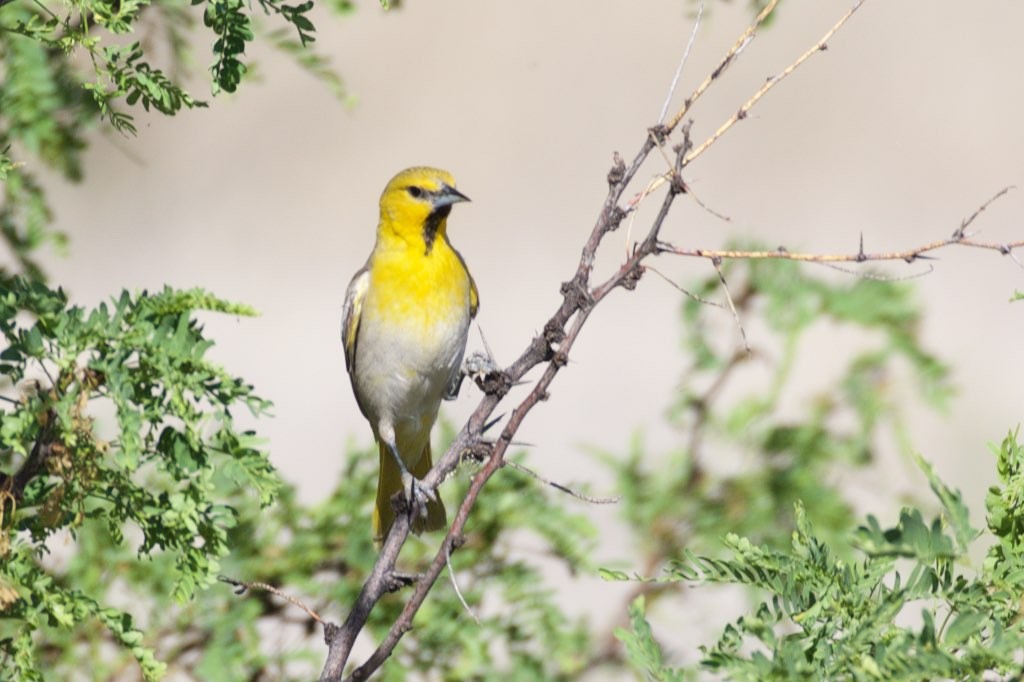Bullock's Oriole
A species of New world orioles Scientific name : Icterus bullockii Genus : New world orioles
Bullock's Oriole, A species of New world orioles
Botanical name: Icterus bullockii
Genus: New world orioles
Content
Description People often ask General Info
Description
The bullock's Oriole is a vibrant bird that will catch your eye with its striking orange feathers, black head, and white wing bars. It is a lively and active feeder, often seen in open woodlands and gardens. Not only is it a beautiful sight, but its melodious, warbling song adds a musical touch to the natural landscape. 
Size
18-21 cm (7-8.25 in)
Life Expectancy
6.08-11.92 years
Nest Placement
Tree
Clutch Size
3 - 7 eggs
Feeding Habits
Bullock's Oriole's diet includes insects like caterpillars, grasshoppers, and crickets, also consuming beetles, ants, various bugs, and small spiders. Fruit such as blackberries, cherries, and figs, along with nectar from flowers like agaves are eaten. For feeding, bullock's Oriole uses 'gaping' to extract juice from fruit and some insects. They remove stingers from bees before consumption and rarely eat small lizards. Nestlings are fed a variety of insects including crickets and moth pupae.
Habitat
Bullock's Oriole is commonly found in a range of open habitats including riparian woodlands, suburban areas, and urban parks. This species prefers lower elevations and thrives in environments with a warm climate. The bird selects areas with large, well-spaced trees such as sycamores, cottonwoods, willows, and various oaks, often near fresh water sources. During breeding, migration, and wintering, bullock's Oriole also inhabits orchards, shrublands, and occasionally pine or fir forests.
Nest Behavior
The female bullock's Oriole selects the nest location, often near other bullock's Oriole nests but not within the male's territory. Nest construction is a shared effort, taking up to 15 days, with partners alternating between inside and outside work. After building, bullock's Oriole's egg-laying and parental care patterns commence.
Nest Characteristics
Bullock's Oriole's typical nest is gourd-shaped, woven from materials like grasses, hair, twine, or wool, and lined with soft feathers or plant 'cotton.' Suspended from tree branches 10-25 feet up, near water, these nests average less than 4 inches deep, can reach 15 inches, with a smaller opening compared to similar species.
Dite type
Insectivorous
People often ask
General Info
Feeding Habits
Bird food type
Bird Feeder Type

Platform
Behavior
During their daily activities, bullock's Oriole engage in gleaning and probing foliage for insects and nectar, adept at hanging upside down while foraging. Their movement is characterized by agile short hops between branches and occasional ground visits for prey capture. With a robust and direct flight pattern, bullock's Oriole are also sociable during migration, forming transient, gender-mixed flocks. They exhibit unique courtship rituals; males impress females with conspicuous bowing and singing displays, alongside vibrant plumage presentation. Females may respond with distinctive wing-quivering displays. Territorial behavior involves intense chases and confrontations among rival males. Bullock's Oriole form monogamous bonds during breeding, collaboratively defending the nest against common predators, with females usually vocalizing in proximity to their nests and males singing from different locations.
Distribution Area
Bullock's orioles are native to western North America, though according to Jaramillo (1999) they are sometimes found as vagrants in the eastern half of the continent. During the breeding season, they are found as far west as the eastern foothills of the Cascade range. Their breeding range stretches east to the Dakotas, Kansas, and northern central Texas. This species can be found as far north as British Columbia in Canada and as far south as Sonora or Durango in Mexico. It is common throughout its range, but is absent in parts of Arizona and Idaho where a combination of extreme elevation and an arid climate make for poor living conditions. During winter, this species retreats to Mexico and northern Central America. Its winter range extends south and east from Sinaloa to Oaxaca. 
